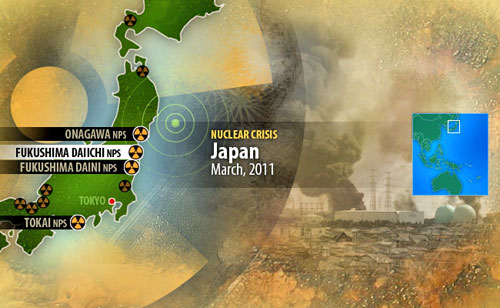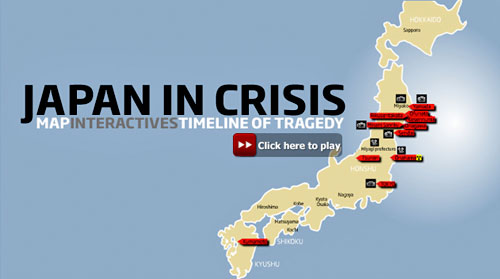|

by Paul Tatnell, Padraic Murphy
March 17, 2011
from
HeraldSun Website
Behind Japan's escalating nuclear crisis
sits a scandal-ridden energy industry in a comfy relationship with
government regulators often willing to overlook safety lapses.
Leaks of radioactive steam and workers contaminated with radiation
are just part of the disturbing catalogue of accidents that have
occurred over the years and been belatedly reported to the public,
if at all.
Nuclear Nightmare

In one case, workers hand-mixed uranium in stainless steel buckets,
instead of processing by machine, so the fuel could be reused,
exposing hundreds of workers to radiation.
Two later died.
"Everything is a secret," Kei
Sugaoka, a former nuclear power plant engineer in Japan who now
lives in California, said.
"There's not enough transparency in the industry."
Sugaoka worked at the same utility that
runs the Fukushima Dai-Ichi nuclear plant where workers are racing
against time to prevent a full meltdown following Friday's 9.0
magnitude quake and tsunami.
In 1989 Sugaoka received an order that horrified him: edit out
footage showing cracks in plant steam pipes in video being submitted
to regulators. Sugaoka alerted his superiors in the Tokyo Electric
Power Co (Tepco) but nothing happened. He decided to go public in 2000.
Three Tepco executives lost their jobs.
The legacy of scandals and cover-ups over Japan's half-century
reliance on nuclear power has strained its credibility with the
public. That mistrust has been renewed this past week with the
crisis at the
Fukushima Dai-Ichi plant.
No evidence has emerged of officials hiding information in this
catastrophe.
But the vagueness and scarcity of details offered by
the government and Tepco - and news that seems to grow worse each
day - are fuelling public anger and frustration.
"I can't believe them," said Taketo
Kuga, a cab driver in Tokyo, where low levels of radiation was
observed on Tuesday, despite being 220km away from the faulty
plant.
Kuga has been busy lately driving to
airports and train stations people eager to get out and flee
southward.
And it unsettles him the information about radiation is
all over the Internet, hours before officials make their
announcements.
"I don't feel safe," he said.
Doubts over whether Japan can contain
its nuclear crisis are growing, as helicopters are used to dump
water on to an overheating power plant and more countries urge
citizens to leave Tokyo.
Radiation levels at Japan's stricken Fukushima nuclear power plant
remained unchanged today after military helicopters dumped water on
the crippled No. 3 reactor in an effort to cool down its storage
pool.
Four military Chinooks ran a mission to empty containers holding
more than seven tonnes of water each on to the nuclear facility,
damaged by Friday's massive 9.0 magnitude earthquake and subsequent
tsunami.
Eleven water cannon trucks also sprayed water from the ground on to
the No. 3 reactor.
But Tokyo Electric Power Co. (TEPCO), which operates the facility,
said the radiation levels had remained the same since the
water-dumping operation was completed.
The radiation level around the plant's buildings was about 3000
microsieverts per hour, TEPCO said, compared to the safe level of
1000 microsieverts.
The operation aims to keep the fuel rods inside reactors and
containment pools submerged, to stop them degrading when they are
exposed to air and emitting dangerous radioactive material.
At the same time, Japanese engineers are focused on restoring the
power supply to the stricken power plant to try to reactivate its
cooling system and avert a meltdown.
The power supply to the Fukushima No. 1 plant on the Pacific coast,
250 km northeast of Tokyo, could partially resume later today, the
country's nuclear safety agency said.
"If the restoration work is
completed, we will be able to activate various electric pumps
and pour water into reactors and pools for spent nuclear fuel,"
a spokesman for TEPCO said.
The power system - and its emergency
diesel-fueled generators - failed when the tsunami hit the complex,
soaking electrical equipment in water.
Since then, overheating has caused four hydrogen explosions and two
fires at the plant as well as a partial meltdown at the No. 1, No. 2
and No. 3 reactors of the six-reactor facility.
"Damage to the cores of the three
units - units 1, 2 and 3 - has been confirmed. The cores remain
uncovered by one or two meters," UN atomic watchdog chief Yukiya
Amano said yesterday.
Mr Amano said the situation was "very
serious" as he prepared to fly out to see the damage for himself.
France said it will send a plane carrying 95 tonnes of boron, an
element that dampens radiation, to help Japan tackle the crisis at
the Fukushima plant, Energy and Industry Minister Eric Besson said.
The first plane carrying 95 tonnes of boron was leaving early
Thursday (local time), Mr Besson told France 2 television. He did
not specify whether the plane was carrying boron, an element that
absorbs neutrons, in powder or liquid form.
Mr Besson said that France had offered the boron on Saturday, the
day after Japan's biggest earthquake on record struck but,
"either they didn't think it was
useful or they didn't have the time to reply."
Mr Amano, the Japanese chief of the
International Atomic Energy Agency, insisted on Tuesday there was no
comparison to the Chernobyl crisis, when radiation spewed across
Europe.
US President Barack Obama offered to give Japan any support it
needed, in a telephone call with Prime Minister Naoto Kan, the
Japanese leader's spokesman said.
But as crews battled to prevent a disastrous meltdown, more foreign
governments urged their citizens to steer clear of quake-stricken
northeast Japan and the capital Tokyo.
Australians in Japan were told to leave Tokyo, amid the worsening
crisis at the power plant and the threat of aftershocks.
Foreign Minister Kevin Rudd said 22 Australians were still
officially missing, but scores were stranded in areas where
radiation levels had soared.
"If you're in Tokyo or any of the
affected prefectures, we are saying that you should depart," Mr
Rudd said.
Britain advised its citizens to consider
leaving Tokyo and northeastern Japan, though UK officials said there
was still "no real human health issue that people should be
concerned about".
French authorities said they were assigning two government planes to
assist French citizens who wanted to leave Japan.
"Given the possible evolution of the
situation, French citizens in Tokyo are recommended to leave the
region for the south of the country or for France," the foreign
ministry said.
US officials warned nationals living
within 80 km of the crippled Fukushima nuclear plant to evacuate or
seek shelter.
The Japanese government told people living up to 10 km beyond the
20-km exclusion zone around the plant to stay indoors. More than
200,000 people had already been evacuated from the zone.
Germany, Italy and the Netherlands also advised their nationals to
leave or refrain from travelling to the northeast.
"The site is effectively out of
control," the European Union's energy chief Guenther Oettinger
told a European Parliament committee, a day after he said Japan
was facing "apocalypse".
France's Nuclear Safety Authority said
the disaster now equated to a six on the seven-point international
scale for nuclear accidents, ranking the crisis second only in
gravity to the level-seven Chernobyl disaster in 1986.
US Energy Secretary Steven Chu said the events in Japan "actually
appear to be more serious" than the
1979 accident at Three Mile
Island, a partial reactor meltdown that led to small releases of
radioactivity.
"To what extent we don't really know
now," Mr Chu said in Washington.
Gregory Jaczko, chair of the US Nuclear
Regulatory Commission, warned there was no water left in the spent
fuel pool of the Japanese plant's No. 4 reactor, resulting in
"extremely high" radiation levels.
The US military would send a spy drone to take a closer look at the
reactors in the troubled plant, Kyodo News reported.
Japan's chief government spokesman Yukio Edano said radiation levels
from the plant posed no immediate health threat outside the 20-km
exclusion zone, despite slightly elevated levels detected in Tokyo
over the past few days.
Aside from the nuclear threat, the full scale of the quake and
tsunami disaster was becoming clear, as more details emerged of the
staggering death and devastation in the worst-hit northeast.
"The number of people killed is
increasing day by day and we do not know how many people have
fallen victim," Japan's Emperor Akihito said in a rare televised
address to the nation yesterday.
"People are being forced to evacuate in such severe conditions
of bitter cold, with shortages of water and fuel... I cannot
help praying that rescue work is done swiftly and people's lives
get better, even a little."
The official toll of the dead and
missing had exceeded 14,000, police said, with the number of
confirmed dead at 5,321.
But reports continued to come in that indicated the final toll could
be much higher. The mayor of the coastal town of
Ishinomaki in
Miyagi prefecture said yesterday that the number of missing there
was likely to hit 10,000.
On Saturday, public broadcaster NHK reported that about 10,000
people were unaccounted for in the port town of
Minamisanriku in the
same prefecture.
Amid a mass rescue effort, there were grim updates indicating severe
loss of life along the battered east coast of
Honshu island, where
the monster waves destroyed or damaged more than 55,380 homes and
other buildings.
Australians stranded in Japan are pleading for help to leave the
devastated country amid growing fears of a nuclear catastrophe. DFAT
is now advising Australians to stay at least 80km from the Fukushima
nuclear plant.
Tokyo was in gridlock with reports thousands were trying to flee
amid fears the wind would bring downpours of nuclear rain. In some
good news, two Australian search and rescue workers are now back on
the job after being exposed to low levels of radioactive
contamination near the stricken Fukushima plant.
But Australians in the zone hardest hit by Friday's tsunami have
also told the Herald Sun they are being urged to get out. Without
petrol, food and water, many have no chance.
Japan in Crisis

|


